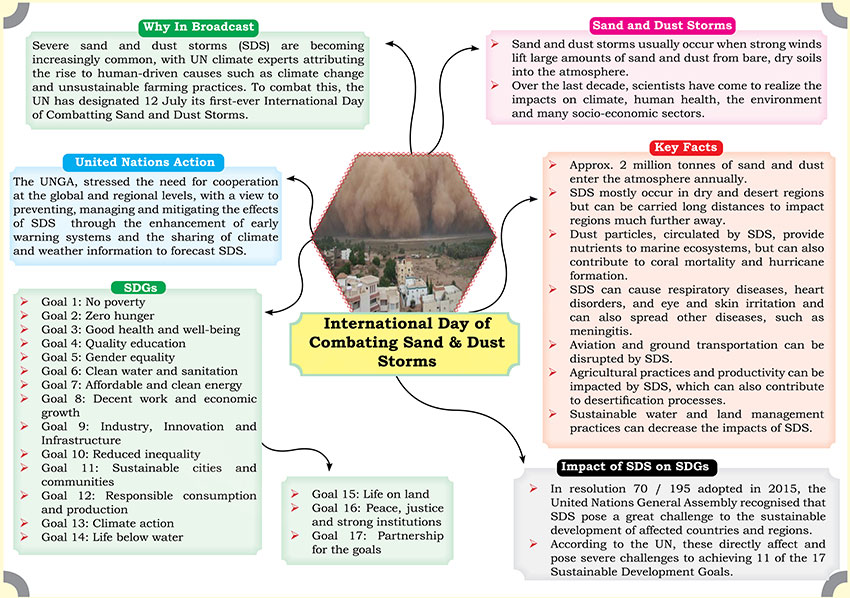Brain-booster /
20 Aug 2023
Brain Booster for UPSC & State PCS Examination (Topic: International Day of Combating Sand & Dust Storms)

Why in Broadcast?
- Severe sand and dust storms (SDS) are becoming increasingly common, with
UN climate experts attributing the rise to human-driven causes such as
climate change and unsustainable farming practices. To combat this, the UN
has designated 12 July its first-ever International Day of Combatting Sand
and Dust Storms.
Sand and Dust Storms
- Sand and dust storms usually occur when strong winds lift large amounts
of sand and dust from bare, dry soils into the atmosphere.
- Over the last decade, scientists have come to realize the impacts on
climate, human health, the environment and many socio-economic sectors.
Key Facts
- Approx. 2 million tonnes of sand and dust enter the atmosphere annually.
- SDS mostly occur in dry and desert regions but can be carried long
distances to impact regions much further away.
- Dust particles, circulated by SDS, provide nutrients to marine
ecosystems, but can also contribute to coral mortality and hurricane
formation.
- SDS can cause respiratory diseases, heart disorders, and eye and skin
irritation and can also spread other diseases, such as meningitis.
- Aviation and ground transportation can be disrupted by SDS.
- Agricultural practices and productivity can be impacted by SDS, which
can also contribute to desertification processes.
- Sustainable water and land management practices can decrease the impacts
of SDS.
Impact of SDS on SDGs
- In resolution 70 / 195 adopted in 2015, the United Nations General
Assembly recognised that SDS pose a great challenge to the sustainable
development of affected countries and regions.
- According to the UN, these directly affect and pose severe challenges to
achieving 11 of the 17 Sustainable Development Goals.
SDGs
- Goal 1: No poverty
- Goal 2: Zero hunger
- Goal 3: Good health and well-being
- Goal 4: Quality education
- Goal 5: Gender equality
- Goal 6: Clean water and sanitation
- Goal 7: Affordable and clean energy
- Goal 8: Decent work and economic growth
- Goal 9: Industry, Innovation and Infrastructure
- Goal 10: Reduced inequality
- Goal 11: Sustainable cities and communities
- Goal 12: Responsible consumption and production
- Goal 13: Climate action
- Goal 14: Life below water
- Goal 15: Life on land
- Goal 16: Peace, justice and strong institutions
- Goal 17: Partnership for the goals
United Nations Action
- The UNGA, stressed the need for cooperation at the global and regional
levels, with a view to preventing, managing and mitigating the effects of
SDS through the enhancement of early warning systems and the sharing of
climate and weather information to forecast SDS.








